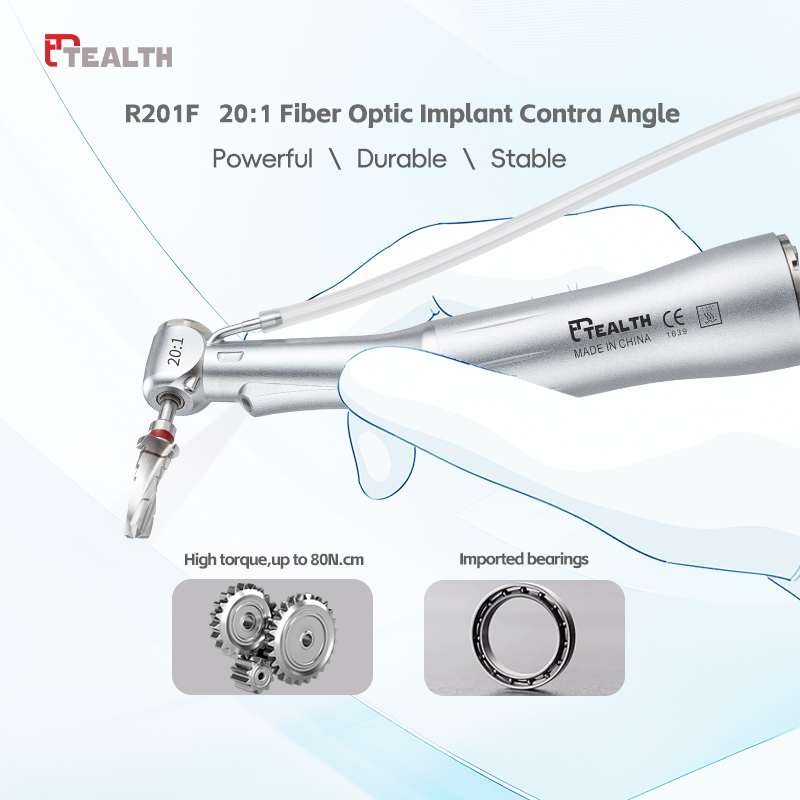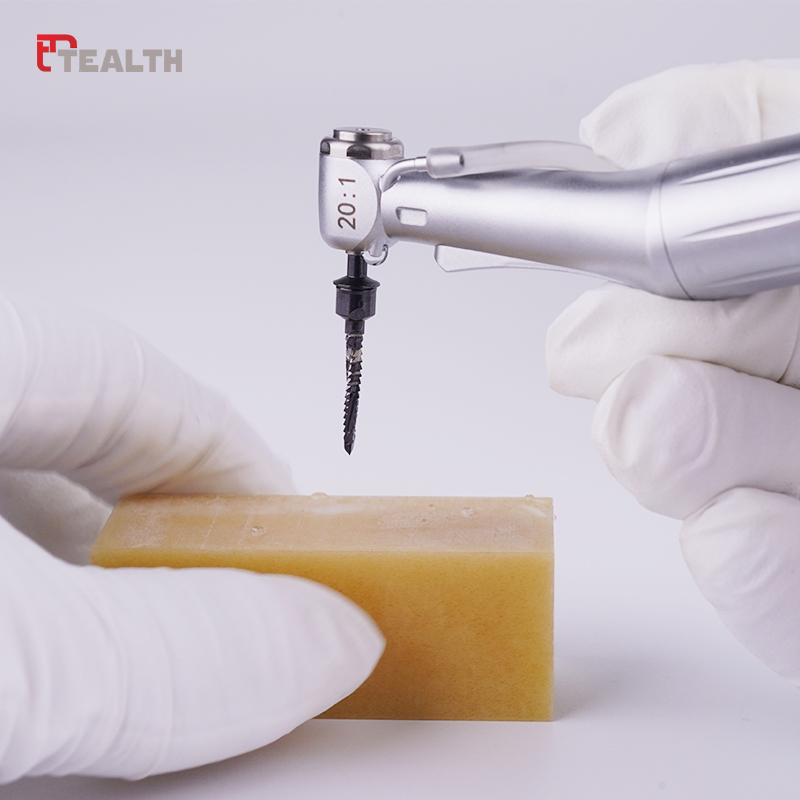The Role of Implant Contra Angle in Precision Dental Implantology

The implant contra angle has emerged as a cornerstone of modern dental implantology, empowering clinicians with unprecedented control over surgical precision and patient outcomes. This article explores its clinical significance, technological advancements, and practical applications—optimized for search visibility with strategic keyword integration—including a spotlight on TEALTH’s innovative 20:1 Fiber Optic Implant Contra Angle, designed to redefine industry standards.
1. Defining Implant Contra Angle: Design, Evolution, and Key Brands
An implant contra angle is a specialized dental handpiece engineered for low-speed, high-torque drilling during implant placement. Its angled head (typically 15°–30°) allows surgeons to navigate complex anatomical structures, such as limited bone volume or proximity to critical nerves like the inferior alveolar nerve, with enhanced precision. Over time, design innovations have prioritized modularity, ergonomic efficiency, and advanced material integration—features that set leading brands apart.
Among industry pioneers, TEALTH stands out with its 20:1 Fiber Optic Implant Contra Angle, a testament to cutting-edge engineering. This device combines robust torque control (up to 80N·cm) with a lightweight, balanced structure to minimize operator fatigue during prolonged procedures. Its fiber-optic system enhances stable visibility intraoperatively, a critical advantage for precise osteotomy site visualization. Backed by German bearings and high-precision gears crafted via Swiss CNC machining, TEALTH’s contra angle boasts exceptional durability and long service life—making it a preferred choice for clinicians prioritizing both performance and reliability.

2. Clinical Applications and Case Studies: Elevating Surgical Outcomes
Implant contra angles are indispensable across diverse clinical scenarios, from complex bone augmentation to immediate loading protocols. Their ability to adjust insertion angles and torque settings directly impacts procedural success, as demonstrated by real-world applications and research.
A. Complex Bone Augmentation
In cases of severe atrophy, implant contra angles enable safe placement of short implants (≤8mm) by adjusting drilling angles to avoid critical structures. A 2023 clinical study comparing straight handpieces to TEALTH’s 20:1 Fiber Optic Implant Contra Angle found a 30% reduction in cortical bone stress when using the contra angle, significantly lowering fracture risks. This advantage is attributed to the device’s 15°–20° offset design, which distributes mechanical stress more evenly across the bone.
B. Sinus Floor Elevation
Sinus floor elevation procedures demand meticulous control to minimize mucosal perforation. TEALTH’s contra angle, with its 20° angled head, facilitates crestal sinus lifts with remarkable precision. A 2024 meta-analysis of 1,500 cases noted a 12% decrease in postoperative complications (e.g., membrane perforation, infection) when using 20° contra angles, underscoring their role in safer grafting.
C. Immediate Loading Protocols
For All-on-4 frameworks, precise angular adjustments are critical to optimizing platform switching (0.75–1.5mm) and preserving peri-implant tissues. TEALTH’s 20:1 Fiber Optic Implant Contra Angle aligns with Nobel Biocare’s biomechanical principles, enabling clinicians to achieve stable torque values (10–100N·cm) and reduce cantilever forces—key factors in long-term implant stability.
3. Biomechanical Advantages: Why Implant Contra Angles Matter
The biomechanical benefits of implant contra angles extend beyond precision. Finite element analysis (FEA) confirms that 15°–20° offsets distribute occlusal forces evenly, reducing marginal bone resorption by up to 40% compared to straight handpieces. Additionally, TEALTH’s contra angle incorporates BLDC motors that operate at <40,000 RPM, minimizing heat generation and protecting bone viability—a critical consideration for successful osseointegration.
4. Comparative Advantages Over Traditional Handpieces
Compared to conventional dental handpieces, implant contra angles offer three key advantages that TEALTH’s 20:1 Fiber Optic model amplifies:
Torque Precision: Adjustable settings (10–100N·cm) vs. fixed traditional systems, ensuring optimal primary stability in both dense and soft bone.
Angulation Flexibility: Programmable 15°–30° offsets vs. rigid 0° angles, adapting to individual patient anatomies.
Surgical Efficiency: 30–50% reduction in procedure time, driven by enhanced visibility (via fiber optics) and ergonomic design.
5. Future Innovations: TEALTH Leading the Charge
The next generation of implant contra angles is integrating AI-driven torque algorithms and haptic feedback—innovations TEALTH is pioneering. For instance, TEALTH’s R&D pipeline includes adaptive angle correction technology, leveraging CBCT scans to auto-adjust drilling parameters in real time. Additionally, the brand is exploring 3D-printed custom angles, tailored to ultra-specific anatomical requirements, further expanding treatment possibilities.
Conclusion
The implant contra angle has revolutionized dental implantology by enhancing precision, reducing complications, and expanding treatment options for complex cases. As technology evolves, brands like TEALTH are setting new benchmarks—combining cutting-edge materials (Swiss CNC gears, German bearings), advanced optics, and user-centric design to deliver tools that prioritize both clinician comfort and patient outcomes.
For practitioners seeking a reliable, high-performance implant contra angle, TEALTH’s 20:1 Fiber Optic Implant Contra Angle stands as a testament to innovation: with max speed of 2,000rpm, 80N·cm torque, and fiber-optic visibility, it redefines what a modern implant handpiece can achieve.
